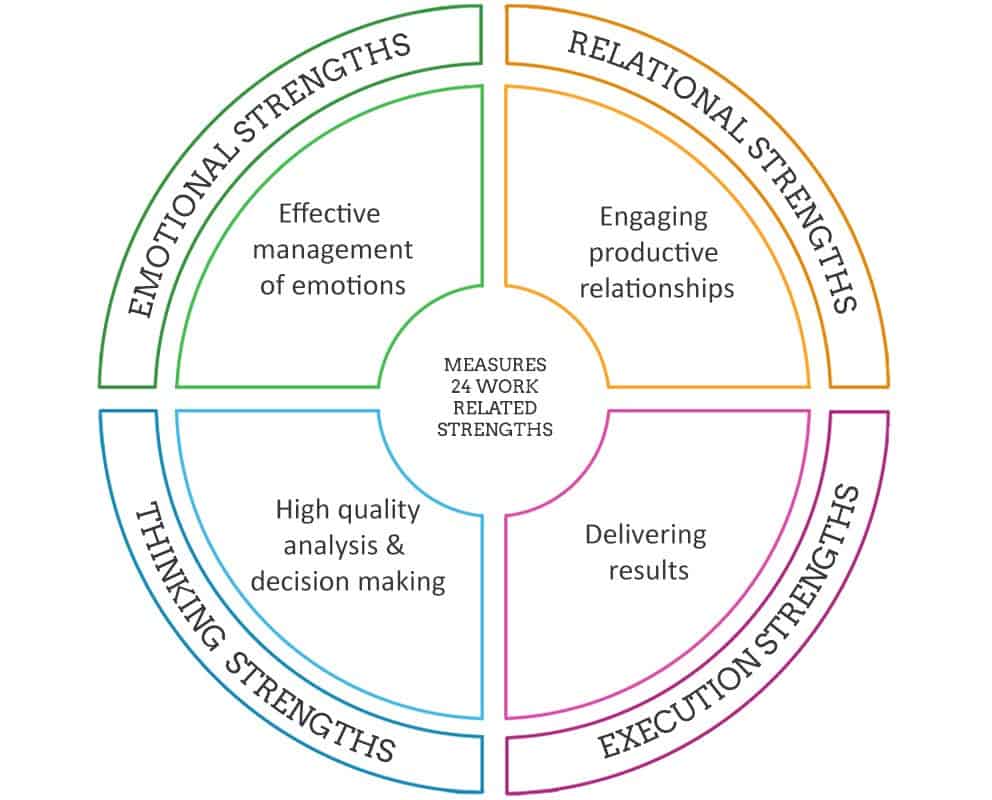The modern strengths-based approach to managing people has been around for nearly 20 years, although many of the central principles and ideas were first introduced by management gurus like Peter Drucker and Dr Bernard Haldane long before this. The central premise is that focusing on strengths is a more powerful way of accelerating learning and performance in organisations because it unlocks people’s passion and energy, helping them achieve excellence in areas more aligned with their natural strengths and personality.
>> Learn how Strengthscope® provides a clear picture of each employee’s strengths at work

Today, strengths-based approaches are one of the fastest growing trends in human resources and for good reason as research shows they can yield significant improvements in employee engagement and productivity of around 40%.
Yet, one of the big mistakes companies make when bringing in this approach, fuelled by the US market leader, Gallup, and other companies working in this area, is to ignore people’s weaker areas and other performance risks.
This is likely to significantly undermine the value of the approach to businesses and result in unfair scepticism and critique by managers, executives and the press.
What happens when strengths-based approaches only focus on strengths?
A host of problems can arise for both the individual and company when there is a myopic focus on strengths without any consideration of weaknesses and other risks to performance. Some of these include:
- A work culture where people think they only need to focus on their natural strengths to be effective resulting in an abdication of responsibility in areas of non-strength.
- An avoidance of performance problems and fatal flaws that can derail a person’s performance and career.
- A failure to improve in areas of non-strength to achieve one’s full potential.
- Lopsided development where people use their strengths too much or in the wrong way, leading to overdrive behaviours and poor performance (this is discussed in more detail below).
Why the strengths approach is so powerful at dealing with weaknesses?
The strengths approach, when implemented in the right way doesn’t ignore weaker areas and other performance risks (including overdone strengths and psychological barriers such as poor self-confidence). In fact, it is far more powerful in helping to deal with these for a variety of reasons:
- It promotes more solutions-based performance and development conversations about how to tackle weaker areas and other risks to peak performance. We coach people to consider creative ways to use their strengths, and those of co-workers, to deal with weaker areas and the breakthrough thinking and response we get is always fantastic.
- Focusing on strengths in a development conversation results in a less threatening, awkward conversation; reducing defensive barriers to talking about weaker areas. One of the underpinning principles of the approach is that we are all ‘spiky’ possessing great strengths and also great vulnerability. We always emphasize this at the outset of a coaching or feedback conversation which encourages people to talk more openly and honestly about their weaker area and other risks/blockers to performance.
- The strengths approach activity encourages people to partner with others who have strengths in areas where they are weaker. This complementary partnering not only helps reduce the impact of weaker areas, it also builds a strong team culture within the organisation.
- The strengths approach is unique in helping people become aware of and reduce strengths that are overdone, or used in the wrong way, at the wrong time or in the wrong combination resulting in disappointing outcomes. For example, people who are too confident may become arrogant and brash, managers that are too compassionate may find it difficult to be directive and tough with staff when required and those that are too creative might overlook obvious, common-sense solutions. The damaging effects of overdone strengths was found in research conducted by Centre for Creative Leadership in the 90’s and should be well established and practiced by now. However, because of the competency and weakness-based nature of most training and development, the vast majority of people we deal with have never had feedback on or considered what happens when their strengths are overplayed. Helping them understand and manage the triggers and limiting effects of overdone strengths is an integral part of the strengths-based approach.
The strengths approach offers tremendous potential and it appears that we are now reaching a ‘tipping point’ where the majority of leading organisations are implementing, or piloting, this approach to people and talent management. However, a sole focus on discovering and optimising people’s strengths will not yield sustainable improvements in engagement and performance. To be effective, a strengths-based HR/talent programme needs to also help people find innovative and powerful ways to reduce their weaker areas, strengths in overdrive and other performance risks, especially when these are limiting the performance and growth of the person, team and/or company.
For more details on how to design and implement a strengths-based strategy that works, please contact us.











